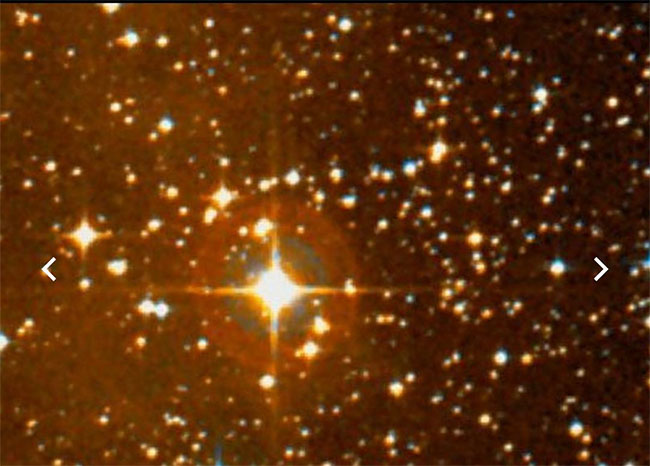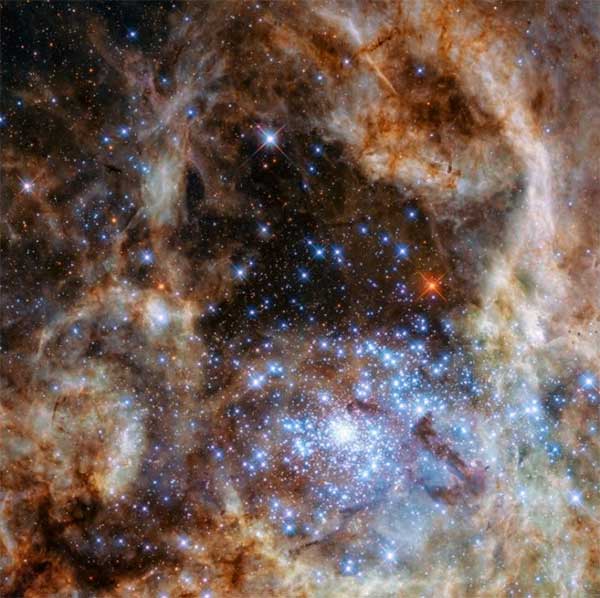How do scientists measure the mass of a star?
Almost everything in the universe has mass, from atoms and subatomic particles, to huge groups of galaxies.
So far, the only things that scientists know of without mass are photons and gluons.

Super-giant star VY Canis Majoris, one of the largest and heaviest stars ever measured by astronomers.
Knowing mass is important, but the objects in the sky are too far away. We cannot touch them, and we certainly cannot weigh them through traditional means. So how do astronomers determine the mass of things in the universe? It is complicated!
The mass of the stars
A typical star has a fairly large mass, far more than the mass of a regular planet. Why pay attention to its volume? This information is important because it gives us clues about the stars' past, present, and future evolution.

Constellation R136, where 9 monster stars are 100 times the mass of the Sun.
Astronomers can use many indirect methods to determine the mass of celestial bodies. A method called a "gravitational lens" will measure the path of light being bent by the gravity of a nearby object. Although the amount of light bent is quite small, if measured carefully, we can find the mass of gravitational force of the object "pulling" light towards it.
Measures the mass of a regular star
It wasn't until the 21st century that astronomers knew how to apply "gravitational lenses" to measure masses of celestial bodies. Before that, they had to rely on measuring stars orbiting a common object in the center - these stars are called "binary stars". The mass of binary stars (including two stars orbiting a common, gravitational, central object) can be measured quite easily.

Sirius A and B, two binary stars located 8.6 light-years from Earth.
First, astronomers will measure the orbits of all the stars in the system. They also calculated the orbital velocity of the stars and then determined the amount of time it took for a star to complete its orbit. That's called the star's "spin cycle" .
Calculate the volume
Once all the information is known, astronomers will perform a number of calculations to determine the mass of stars. They can use the equation V (orbit) = SQRT (GM / R) , where SQRT is the square root, G is gravity, M is mass, and R is the radius of the object. Through algebraic methods, they will solve that equation to find M.
Thus, without touching a star, astronomers can use known mathematics and laws of physics to find its mass. However, they cannot do it with every star. There are other methods of measurement that can help find the masses of stars that are not in binary or multi-star systems. For example, they can use brightness and temperature . Stars with different brightness and temperature have very different masses. That information, when included in a chart, shows that stars can be classified by temperature and brightness.
Really big stars are the hottest stars in the universe. Lower mass stars, such as the Sun, have lower temperatures than their giant brothers. The graph of the star's temperature, color, and brightness is called the Hertzsprung-Russel Chart , and it also shows the mass of a star depending on its position in the chart. If it lies along a long, winding curve, called the Main Sequence, then astronomers will know that its mass is neither giant nor small. The stars with the largest and smallest mass are all outside the Main Sequence.

Hertzsprung-Russell diagram
Star evolution
Astronomers know the stars' process of birth, existence, and death. This time series of existence and death is called "star evolution". The biggest factor that contributes to predicting how a star will evolve is its mass at birth - or "initial mass". Small-mass stars are usually colder and less light than larger mass brethren. Therefore, just by looking at the color, temperature, and its position in the Hertzsprung-Russell diagram, astronomers will be able to grasp the mass of a star. Comparing between similar stars with known mass (like the binary stars mentioned above), astronomers will know just how big a star is, even if it is not a star. binary.
Of course, the mass of stars does not stay the same throughout its lifetime. As they age, their mass decreases. They will gradually consume their nuclear fuel, and will eventually experience a period of significant mass decline at the end of their lifecycle. If they were stars like the Sun, they would turn off and form a nebula. If they were much heavier than the Sun, they would die during supernova events, when their cores would collapse and then explode after a horrific explosion. This explosion will shoot a large amount of star material into space.

Crab Nebula.
By observing the type of stars that die in the same way as the Sun, or die from a supernova event, astronomers can deduce what other stars will look like. They know their mass, they know how other stars of similar mass will evolve and die, and so they can make some fairly accurate predictions, based on color observations. , temperature, and other aspects that help them understand their mass.
Observing stars is not merely about collecting data. The astronomers' information will be fed into highly accurate models, which will help them predict exactly what stars in the galaxy and in the entire universe will look like when they are born. out, grow, and die - it's all based on their mass. And that information also helps us better understand the stars, especially our sun!
- The mysterious age of the mysterious star
- Deadly giant stars swallow their companions
- Detecting unprecedented neutron stars, challenging the physical limit
- For the first time, the scientific community determined the mass of a star
- Body mass index BMI cannot assess whether you are overweight or underweight
- Found a new type of black hole, hidden in dense star clusters
- The scientists were skeptical of discovering Star Death
- The mass of the Milky Way
- Strange star makes scientists lose sleep
- The Milky Way has a mass of 700 billion times the Sun.
- The Kilogram unit is about to be redefined
- Old ancient stones measure wrongly for millions of years!
 Van Allen's belt and evidence that the Apollo 11 mission to the Moon was myth
Van Allen's belt and evidence that the Apollo 11 mission to the Moon was myth The levels of civilization in the universe (Kardashev scale)
The levels of civilization in the universe (Kardashev scale) Today Mars, the sun and the Earth are aligned
Today Mars, the sun and the Earth are aligned The Amazon owner announced a secret plan to build a space base for thousands of people
The Amazon owner announced a secret plan to build a space base for thousands of people